Architecture Home Styles
Timber: How It Brings the Most Money
Hoping to boost your profits? Find out how strategic decisions in timber harvesting and sales can lead to financial success.

When it comes to timber, understanding the market dynamics can significantly impact your profits. Evaluating factors like tree species, market demand, and direct selling to sawmills can be key to maximizing returns.
By focusing on quality, quantity, and market trends, one can navigate the complexities of the timber industry and ensure a lucrative outcome.
Stay tuned to discover how strategic decisions in timber harvesting and sales can lead to financial success.
Key Takeaways
- Understand timber quality and market demand for optimal pricing
- Direct selling boosts profits by eliminating middlemen costs
- Harvest strategically based on market conditions for maximum profit
- Stay informed on timber market trends for lucrative decision-making
Timber Pricing Factors to Consider
When evaluating timber pricing factors, we prioritize analyzing tree species, quality, volume, and market demand to maximize profitability. Different tree species have varying values per acre, with hardwoods typically fetching higher prices due to their durability and versatility in various industries. Assessing the quality of the timber is essential, as it directly impacts the selling price. Higher-quality timber commands a premium in the current market, reflecting the demand for strong and defect-free wood products.
Volume is another crucial aspect to consider when pricing timber. The quantity of wood available for harvest on a particular land parcel influences its overall value. Larger volumes often lead to economies of scale, driving down costs and increasing profitability.
Understanding the current market demand is key to optimizing pricing strategies. Keeping abreast of market trends and consumer preferences allows us to align our timber offerings with what buyers are seeking, ensuring a competitive edge in the industry. By carefully evaluating these factors, we can make informed decisions that maximize the profit potential of our timber sales.
Benefits of Selling Timber Directly
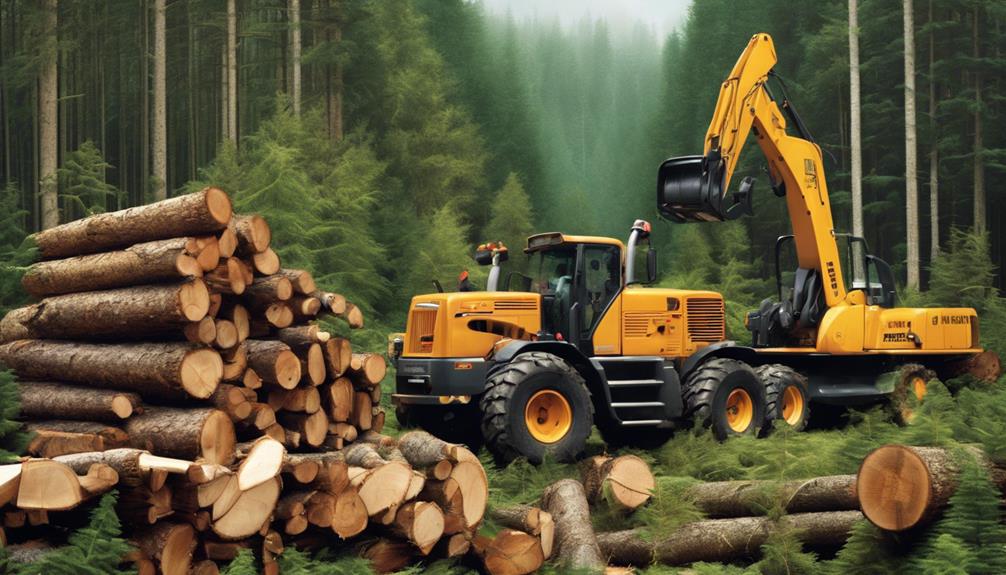
How can selling timber directly to a sawmill significantly impact your profitability and control over the sales process? When you sell timber directly, you open up opportunities to maximize profits and streamline the selling process. Here are some key benefits to consider:
- Increased Profit Margins: By bypassing middlemen costs, you can ensure that more money goes directly into your pocket.
- Enhanced Control: Direct negotiation with the sawmill allows you to have better control over pricing and the terms of the sale, giving you more power in the transaction.
- Streamlined Process: Selling to a sawmill eliminates the need for brokers, consulting foresters, or loggers, simplifying the selling process and saving you time and resources.
- Maximized Profitability: By tapping into both primary and secondary end users of wood products, selling directly to a sawmill can help you maximize profitability by reaching a broader market.
When you choose to sell timber directly, you put yourself in a position to make much more money and have greater control over your sales strategy.
Maximizing Profits: Timber Harvesting Tips
To maximize profits in timber harvesting, strategic timing and sustainable practices are essential for long-term financial success. Harvesting standing timber at the right moment can significantly impact the revenue generated. By timing the harvest based on optimal market conditions, forest owners can capitalize on higher demand and prices, resulting in increased returns. Considering factors such as the age and size of the timber is crucial for determining the most lucrative harvest time.
Utilizing sustainable forestry practices not only ensures long-term profitability but also enhances the overall value of the timber. By managing forests responsibly, forest owners can maintain the health and productivity of the land, leading to continued income from timber harvesting in the future. Properly valuing the timber based on quality and current market prices is also essential for maximizing profits. By staying informed about market trends and demand, forest owners can make informed decisions that result in higher financial gains.
Implementing these tips can help forest owners optimize their profits and sustainably manage their timber resources for long-term success.
Understanding Timber Market Trends

Analyzing recent timber market trends reveals valuable insights into supply and demand dynamics, essential for strategic decision-making in the forestry industry. Recent fluctuations in wood fiber demand due to COVID-19 highlight the importance of staying informed about timber market trends. Market opportunities exist for selling timber from young pine stands and older pine sawtimber. Understanding values over a 3-year period (2017-2019) offers insights into pine stumpage values from timber sales in the US South. Factors such as location, surrounding mill types, proximity to mills, and timber product types influence demand and value per acre.
- Data-driven analysis of pine stumpage values from 2017-2019 in the US South
- Impact of COVID-19 on wood fiber demand and its implications for the timber market
- Opportunities for selling timber from different age stands and product types
- Influence of location, mill types, and proximity to mills on timber demand and value
Tax Implications of Selling Timber
Understanding the tax implications of selling timber involves careful consideration of whether it's classified as a capital asset or ordinary income, impacting the applicable tax rates and treatment. If the timber is held for investment purposes, capital gains tax rates may apply, potentially offering tax advantages.
On the other hand, if the timber is sold as part of a business operation or trade, ordinary income tax rates might come into play, affecting the overall tax liability. Factors such as holding period, intention of sale, and level of involvement in the timber business can influence the tax treatment.
Ensuring compliance with tax regulations and maximizing tax efficiency is crucial when selling timber to make sure you benefit from the most favorable tax treatment. Consulting a tax professional can help navigate the complex tax implications, optimize tax strategies, and potentially increase profits from the sale of timber.
Frequently Asked Questions
What Timber Brings the Most Money?
We know that various factors influence timber's monetary value. Demand and scarcity play crucial roles, with hardwood species like black walnut and oak often commanding high prices due to market demand.
Additionally, old-growth trees with large diameters tend to fetch more money than younger ones. Understanding these dynamics can help us navigate the timber market strategically and make informed decisions to maximize profits.
Why Is Timber so Valuable?
Timber is so valuable for numerous reasons. Its versatility across industries like construction and energy production drives global demand, increasing its worth.
Premium species like teak and mahogany fetch high prices. Factors like age, size, and quality impact value. Sustainable harvesting practices maintain long-term profitability.
Understanding these dynamics helps us grasp why timber holds such immense value in today's market.
How Does Timber Help the Economy?
Timber plays a crucial role in boosting the economy through various channels. It contributes significantly to job creation, supports industries like construction and furniture, and aids in maintaining a positive trade balance through exports.
Sustainable timber management practices are essential for long-term economic growth. Overall, the timber industry's impact on the economy is substantial and multi-faceted, making it a valuable asset for our economic landscape.
What Are the Biggest Uses of Timber?
When considering the biggest uses of timber, construction emerges as a primary driver, consuming approximately 40% of the global timber supply.
Following closely behind is the paper industry, accounting for about 30% of timber usage for paper and pulp production.
Furniture manufacturing also significantly relies on timber, utilizing around 20% of harvested timber worldwide.
These sectors collectively showcase the diverse and essential role timber plays in various industries.
Conclusion
In conclusion, selling timber directly to sawmills can lead to higher profits due to reduced middlemen costs and increased control over pricing negotiations.
By understanding timber pricing factors, maximizing harvesting efficiency, and staying informed on market trends, one can optimize their returns.
Just like a well-tended forest yielding valuable timber, strategic planning and market knowledge can help us grow our financial wealth steadily over time.
- About the Author
- Latest Posts
Introducing Ron, the home decor aficionado at ByRetreat, whose passion for creating beautiful and inviting spaces is at the heart of his work. With his deep knowledge of home decor and his innate sense of style, Ron brings a wealth of expertise and a keen eye for detail to the ByRetreat team.
Ron’s love for home decor goes beyond aesthetics; he understands that our surroundings play a significant role in our overall well-being and productivity. With this in mind, Ron is dedicated to transforming remote workspaces into havens of comfort, functionality, and beauty.
Architecture Home Styles
Maximizing Efficiency: Discovering the Most Efficient Shape for Your House
Get ready to explore the secrets of efficiency in house design, uncovering the perfect shape that harmonizes with nature and optimizes functionality.

When envisioning the most efficient shape for your house, imagine a structure seamlessly blending with its surroundings, harnessing nature's elements to enhance functionality.
Exploring how different shapes can optimize energy usage and space utilization opens doors to innovative possibilities.
By diving into the intricacies of design and functionality, one can uncover the key to a harmonious living space that not only adapts to your needs but also operates in harmony with the environment.
Let's unravel the mysteries of efficient house shapes and unlock the potential for a home that transcends mere shelter.
Key Takeaways
- Efficient house shapes optimize energy use and enhance comfort.
- Strategic design maximizes natural light and ventilation for a healthier environment.
- Energy consumption reduced through smart layout and sustainable lifestyle choices.
- Space optimization and functionality drive efficiency in house shapes.
Benefits of Efficient House Shapes
When designing a home, the benefits of choosing an efficient house shape are numerous and impactful on energy consumption and overall comfort levels. Efficiency is key in reducing energy consumption and promoting sustainable living practices. A well-thought-out house shape can significantly lower utility bills by optimizing natural lighting and ventilation, thus decreasing the need for artificial heating or cooling. By minimizing heat loss or gain, the right house shape enhances indoor comfort levels, creating a more pleasant living environment. Additionally, certain house shapes can improve energy efficiency, ultimately reducing the carbon footprint associated with household operation.
The orientation and layout of a house shape play a crucial role in maximizing solar gain for passive heating benefits. By harnessing natural resources effectively, an efficient house shape contributes to sustainable living practices and environmental conservation. Choosing a design that prioritizes efficiency isn't only beneficial for personal comfort and energy savings but also for the planet as a whole.
Impact of Natural Light and Ventilation
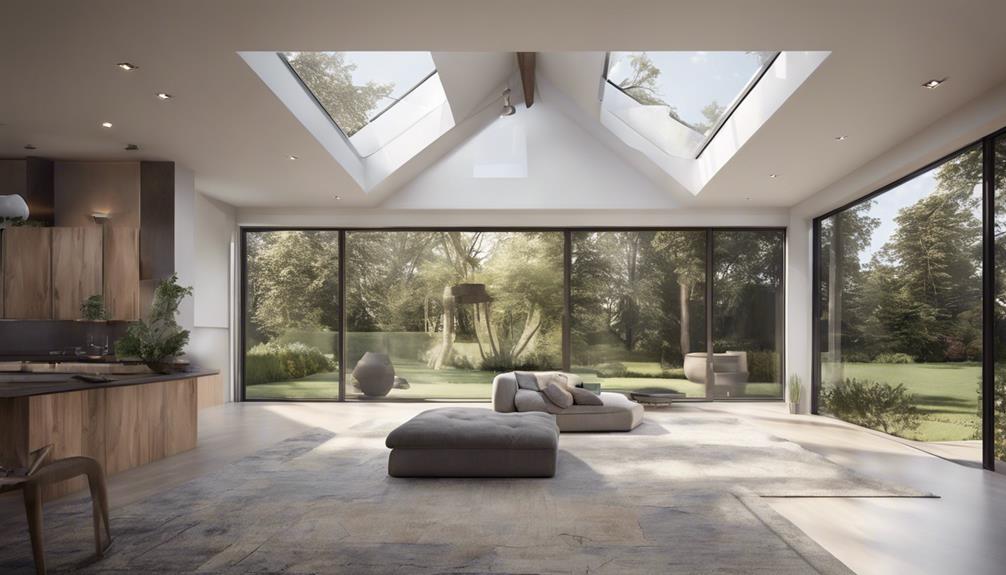
Efficient house shapes not only impact energy consumption and comfort levels but also play a crucial role in maximizing natural light and ventilation for optimal living conditions. When designing a house, our team members collaborate to delegate tasks effectively, ensuring that natural light and ventilation are prioritized. By strategically placing windows and skylights, we can harness natural light to reduce the need for artificial lighting, promoting energy efficiency. Additionally, incorporating cross-ventilation design with windows on opposite walls enhances airflow, lessening the reliance on mechanical ventilation systems. To maintain a balance between daylighting and glare prevention, our team integrates shading elements like overhangs or blinds into the design. Studies support that exposure to natural light not only improves mood and productivity but also enhances overall health. Below is a table highlighting the key considerations for optimizing natural light and ventilation in house design:
| Consideration | Description | Importance |
|---|---|---|
| Window Placement | Strategic positioning to maximize natural light intake and airflow. | High |
| Cross-Ventilation Design | Utilizing windows on opposite walls for effective air circulation. | Medium |
| Shading Elements Integration | Incorporating overhangs or blinds to control natural light and prevent glare. | High |
Energy Consumption Reduction Strategies
Implementing energy-efficient strategies such as upgrading appliances, improving insulation, and utilizing programmable thermostats can significantly reduce household energy consumption. When striving to enhance energy efficiency, consider the following strategies:
- Upgrade to Energy-Efficient Appliances: Investing in energy-efficient appliances can lead to savings of up to 30% on energy consumption, reducing both environmental impact and utility costs.
- Improve Insulation and Sealing: Enhancing insulation and sealing in your home can decrease energy loss by 20%, resulting in substantial savings on heating and cooling expenses over time.
- Utilize Programmable Thermostats: By using programmable thermostats, you can save approximately 10% on annual heating and cooling bills, optimizing your home's energy usage based on your work environment and daily time blocks.
- Install Energy-Efficient Windows: Installing energy-efficient windows can lower energy usage for heating and cooling by up to 25%, contributing to a more sustainable and cost-effective living space while helping you stay focused and productive.
Layouts for Maximizing Efficiency
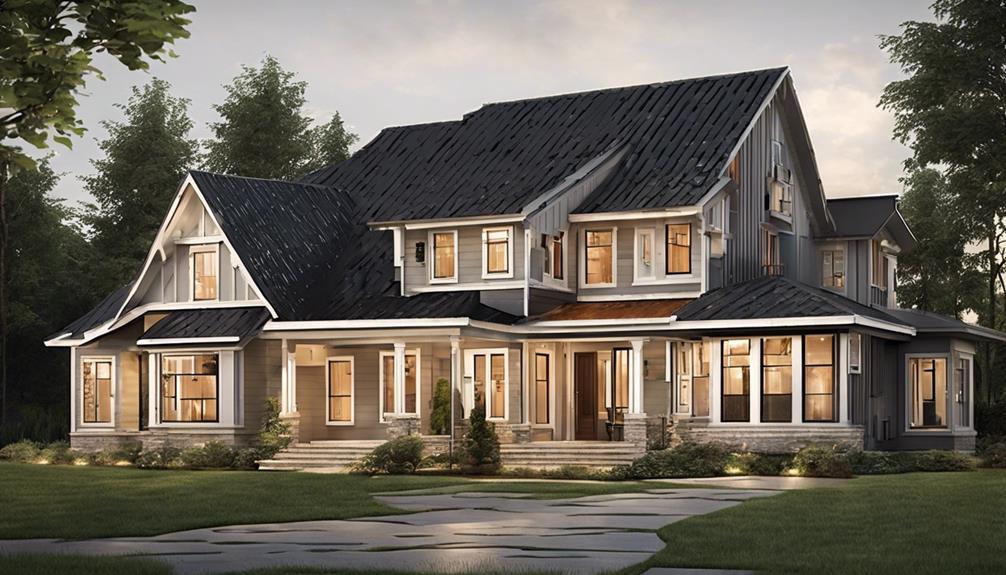
To optimize the efficiency of your home, consider incorporating layouts that maximize space utilization and enhance functionality. Open floor plans and minimal corridors are optimal choices as they enhance spatial efficiency.
Multifunctional furniture and storage solutions are key in maximizing space utilization within house layouts. When designing, prioritize natural light sources and ventilation systems to reduce energy consumption and improve indoor air quality.
Efficient layouts should prioritize traffic flow, minimizing unnecessary detours between rooms. Strategic placement of rooms, such as positioning kitchens near dining areas, streamlines daily activities and enhances convenience.
During the design process, engaging in team meetings to discuss layout options can provide valuable insights and perspectives. Creating detailed to-do lists can help stay organized and ensure all aspects of layout efficiency are considered.
Additionally, engaging in exercises like room mock-ups or walkthroughs can help visualize the flow and functionality of the space. By incorporating these strategies, you can create a home layout that maximizes efficiency and enhances daily living experiences.
Sustainable Lifestyle Design Options
Exploring sustainable lifestyle design options opens up a world of possibilities for creating eco-friendly and energy-efficient homes. When considering the design of a sustainable house, incorporating elements such as passive solar design, energy-efficient appliances, and eco-friendly building materials can significantly enhance its overall sustainability. To further boost eco-friendliness, additional features like green roofs, rainwater harvesting systems, and solar panels can be integrated into the design to minimize the environmental impact of the house.
- Passive Solar Design: Utilizing the sun's energy for heating and lighting purposes can help reduce reliance on traditional heating and lighting systems.
- Energy-Efficient Appliances: Opting for appliances with high energy efficiency ratings can lower electricity consumption and minimize the house's carbon footprint.
- Eco-Friendly Building Materials: Using sustainable and recyclable materials in construction not only reduces waste but also promotes environmental conservation.
- Smart Home Technology: Incorporating smart devices for energy management can further optimize energy usage and enhance the overall efficiency of the house.
Frequently Asked Questions
What Does Maximizing Efficiency Mean?
Maximizing efficiency means optimizing resources to achieve the best possible outcome. It involves streamlining processes, reducing waste, and enhancing productivity. By focusing on efficiency, we can accomplish more with less, saving time and resources.
How Do You Maximize Efficiency?
To maximize efficiency, we embrace smart design choices like space-saving furniture and energy-efficient appliances. By creating multi-functional rooms with ample natural light and ventilation, we streamline our living spaces for optimal functionality and well-being.
How Do You Max Out Efficiency?
When we max out efficiency, we focus on smart design, multi-functional furniture, energy-efficient appliances, and automation. By incorporating these elements, we create a space that optimizes usage, reduces costs, and streamlines daily tasks for a more efficient lifestyle.
How Did You Ensure That Efficiency Would Be Maximised?
We ensured efficiency by strategically designing with a rectangular shape, optimizing natural light through well-placed windows and doors. Smart technology and centralized utilities further streamlined maintenance. Insulation and energy-efficient appliances minimized costs. Our approach maximized functionality and comfort.
Conclusion
In conclusion, by choosing the most efficient shape for your house, you can transform your living space into a powerhouse of energy savings and eco-friendly living.
With the right design choices and sustainable practices, your home can become a beacon of efficiency that not only saves you money but also helps protect the environment.
So, why settle for anything less when you can have a home that's truly optimized for maximum efficiency?
- About the Author
- Latest Posts
Introducing Ron, the home decor aficionado at ByRetreat, whose passion for creating beautiful and inviting spaces is at the heart of his work. With his deep knowledge of home decor and his innate sense of style, Ron brings a wealth of expertise and a keen eye for detail to the ByRetreat team.
Ron’s love for home decor goes beyond aesthetics; he understands that our surroundings play a significant role in our overall well-being and productivity. With this in mind, Ron is dedicated to transforming remote workspaces into havens of comfort, functionality, and beauty.
Architecture Home Styles
What Elements Define Tropical Design Style?
Curious about what elements define tropical design style? Explore how patterns, textures, and colors come together to create a paradise in your home.
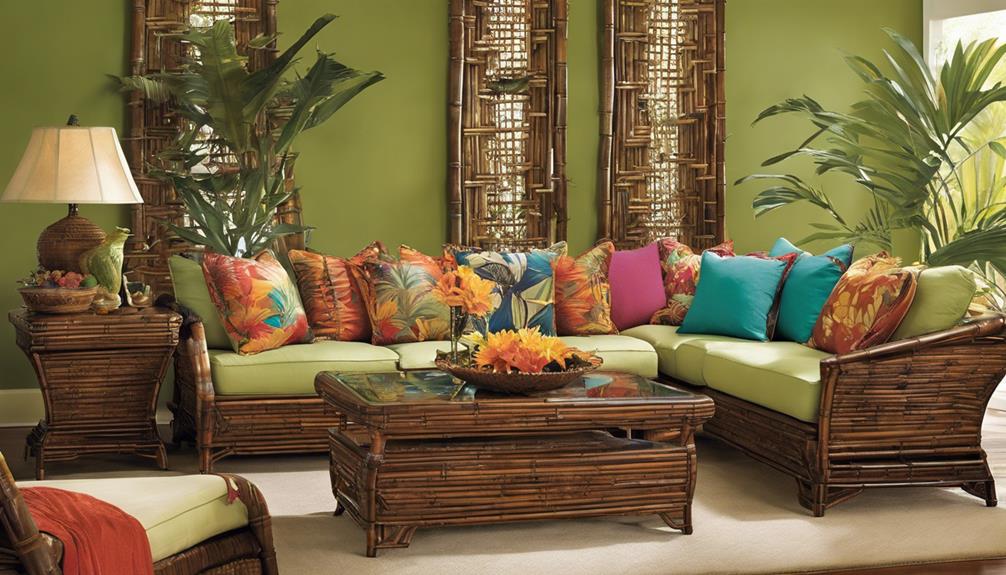
In the world of interior design, the lush greenery and vibrant colors of tropical style symbolize a retreat into nature and relaxation.
But what truly defines this design aesthetic? From patterns and prints to natural textures and materials, tropical design style encompasses a range of elements that evoke a sense of paradise within your home.
Let's explore how each element contributes to creating a space that transports you to a tropical oasis, inviting you to unwind and indulge in the beauty of your surroundings.
Key Takeaways
- Bold patterns and prints like palm motifs bring vibrancy and nature indoors.
- Incorporating greenery fosters tranquility and adds a lush tropical feel.
- Vibrant colors like turquoise and yellow create energizing and visually stimulating spaces.
- Natural textures such as rattan and bamboo enhance the tropical ambiance authentically.
Patterns and Prints
Incorporating bold and vibrant patterns inspired by nature is a key aspect of the tropical design style, instantly infusing spaces with a playful and exotic ambiance. Tropical walls adorned with palm tree motifs or banana leaves bring a touch of the tropics indoors. These natural materials, whether in wallpapers or textiles, add texture and depth to a room, creating a sense of lushness and vitality.
The use of palm prints on cushions or curtains can transport you to a sunny beach or a tropical forest, making you feel connected to nature even when indoors. The intricate details of these patterns mimic the beauty of the outdoors, allowing you to escape to a paradise of your own making. By incorporating these lively designs, you can transform any space into a vibrant tropical oasis, where the energy of nature flows freely. Embracing these bold prints is a sure way to inject life and personality into your home decor.
Greenery and Houseplants

Greenery and houseplants breathe life into tropical design, infusing spaces with lushness and vibrancy. These essential elements bring a touch of nature indoors, creating a tropical oasis. From towering palm trees to the sturdy snake plants, each addition regulates air quality while enhancing the aesthetic appeal. The variety of green plants used in tropical design not only refreshes the atmosphere but also evokes a sense of relaxation akin to tropical environments.
Incorporating houseplants of different sizes and shapes adds depth to the design, amplifying the tropical vibe within the space. The presence of greenery doesn't just contribute to the aesthetics but also fosters tranquility and a deeper connection to nature. The overall ambiance is elevated, making the space feel like a tropical paradise. By strategically placing these plants, one can achieve a harmonious balance between nature and interior design, resulting in a vibrant and inviting tropical setting.
Vibrant Tropical Colors
The lush greenery and houseplants in a tropical design effortlessly lead us into a vibrant world of tropical colors, including turquoise, aqua, green, yellow, and orange. These vibrant colors form the essence of a tropical palette, capturing the natural beauty of tropical environments with their dynamic and lively hues. To showcase the range and impact of these colors, let's explore a table highlighting their significance:
| Tropical Color | Description |
|---|---|
| Turquoise | Evokes the |
| crystal-clear | |
| waters of | |
| tropical beaches | |
| Aqua | Resembles the |
| refreshing | |
| tropical seas | |
| Green | Reflects the |
| lush foliage and | |
| jungles | |
| Yellow | Mimics the |
| bright sunshine | |
| of the tropics | |
| Orange | Symbolizes the |
| warmth and | |
| energy of | |
| tropical climates |
These vibrant tropical colors work harmoniously to create a visually stimulating and energizing tropical design style that transports us to a dynamic and lively oasis.
Natural Textures and Materials
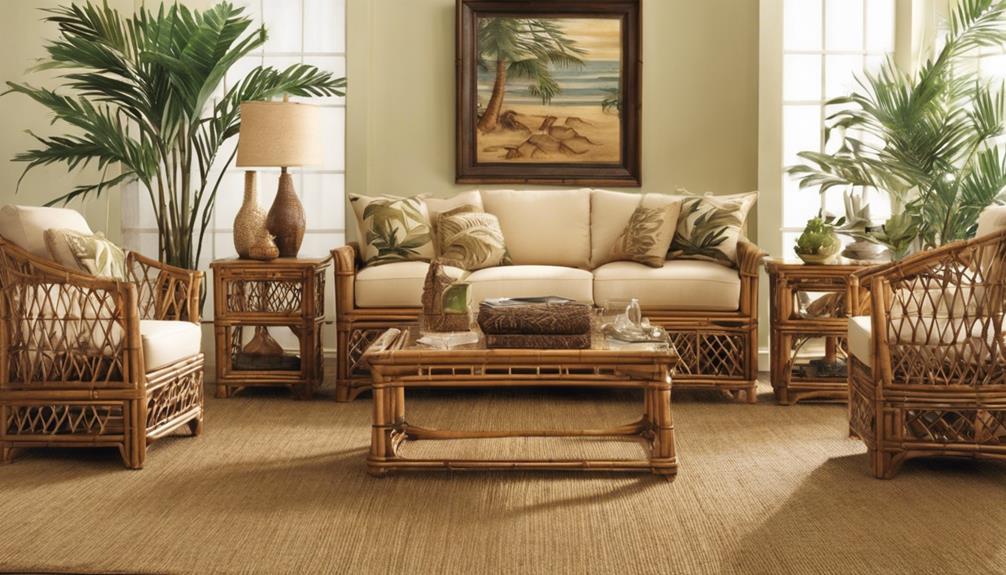
Enhancing the tropical ambiance, natural textures and materials like rattan, bamboo, and wicker infuse an authentic feel into the design space. These elements play a crucial role in creating a modern tropical interior that's both stylish and inviting. Here's how natural textures and materials contribute to the overall tropical design aesthetic:
- Organic Materials: Using materials like jute, seagrass, and teak helps to enhance the tropical vibe, bringing a touch of nature indoors.
- Natural Fibers: Incorporating natural fibers such as linen and cotton adds a light and breezy feel to the space, perfect for capturing the essence of a tropical paradise.
- Earthy Elements: Wood, stone, and water features not only add visual interest but also evoke a sense of the outdoors, promoting a connection with nature.
- Sustainability: Opting for sustainable materials like reclaimed wood and eco-friendly fabrics aligns with the tropical style's emphasis on natural living, promoting fresh air and a tranquil environment within the home.
Light and Airy Spaces
Creating an ambiance that feels light and airy is essential in tropical design style, achieved through strategic use of natural light and ventilation techniques. In tropical interiors, the emphasis is on harnessing the natural elements to create a sense of openness and spaciousness. Light-colored walls and furnishings play a crucial role in reflecting light and enhancing the overall brightness of the space. To maximize natural light, large windows, skylights, and glass doors are commonly incorporated, blurring the boundaries between indoor and outdoor areas. Additionally, light, sheer curtains or blinds are utilized to allow sunlight to filter through while maintaining privacy.
The use of lightweight fabrics, open shelving, and minimalistic furniture further contributes to the light and airy feel of tropical design style. These elements not only promote a breezy atmosphere but also evoke a sense of tranquility and relaxation. By embracing natural light and ventilation, tropical interiors create a welcoming and refreshing environment that invites a connection with the outdoors.
Frequently Asked Questions
What Are the Elements of Tropical Style?
When we think about tropical style, certain elements immediately come to mind. From vibrant colors that exude warmth to materials like wicker and rattan that invite a sense of relaxation, tropical design is all about blending indoors with the outdoors seamlessly.
Elements such as natural fabrics, pitched roofs for rain protection, and a focus on light and water all play a crucial role in defining this style that brings a touch of paradise into your home.
How to Design a Tropical Style?
When designing a tropical style, we focus on creating a lush and vibrant ambiance. Infusing bold patterns, green leaves, and natural textures is essential.
To achieve this, we incorporate elements like houseplants, rattan furniture, and colorful prints. By embracing the beauty of nature and incorporating personal style into decor choices, we can bring the tropical paradise indoors.
Let's transform our space into a relaxing oasis with vibrant hues and natural elements.
What Is Tropics Style?
When it comes to tropical style, we're talking about a design aesthetic inspired by the vibrant elements of nature like weather, sun, and water.
This style often blurs the lines between indoor and outdoor spaces, bringing in elements like pitched roofs and palapas for a seamless transition.
Think wicker, rattan, and natural fabrics like linen and cotton to create that laid-back, island vibe that defines tropical design.
What Materials Are Used in Tropical Interior Design?
When designing with a tropical vibe, we gravitate towards natural materials like wicker, bamboo, and teak to evoke that lush paradise feel. These elements infuse our spaces with warmth and relaxation.
Fabrics like linen and cotton enhance the airy ambiance, while seagrass rugs and sisal carpets bring in texture and earthy charm.
Plantation shutters made of wood or bamboo not only add a tropical touch but also allow us to control the light effortlessly.
Conclusion
In conclusion, the tropical design style brings a touch of paradise into your home with its vibrant colors, lush greenery, and natural textures.
Imagine lounging on a wicker chair surrounded by tropical prints and houseplants, basking in the warm glow of natural light.
The soothing ambiance created by these elements will transport you to a tropical oasis, where relaxation and creativity thrive.
Embrace the tropical design style to infuse your space with a sense of tranquility and exotic charm.
- About the Author
- Latest Posts
Introducing Ron, the home decor aficionado at ByRetreat, whose passion for creating beautiful and inviting spaces is at the heart of his work. With his deep knowledge of home decor and his innate sense of style, Ron brings a wealth of expertise and a keen eye for detail to the ByRetreat team.
Ron’s love for home decor goes beyond aesthetics; he understands that our surroundings play a significant role in our overall well-being and productivity. With this in mind, Ron is dedicated to transforming remote workspaces into havens of comfort, functionality, and beauty.
Architecture Home Styles
What Is the Difference Between Modern and Mid-Century Modern Design?
Only subtle distinctions separate modern and mid-century modern design, enticing readers to uncover the nuanced differences in these popular interior styles.
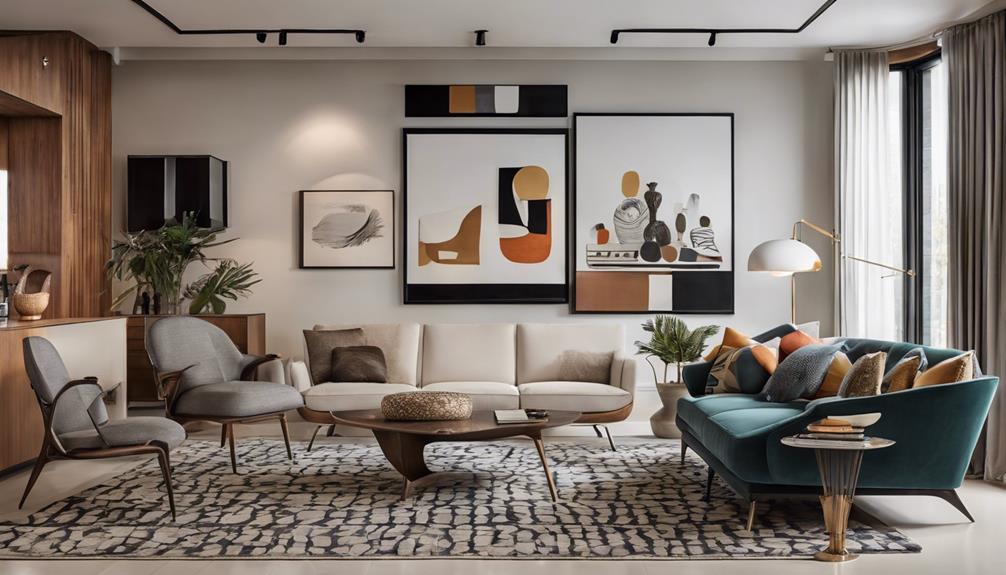
When it comes to distinguishing between modern and mid-century modern design, the differences go beyond mere aesthetics. While both styles share some similarities, such as clean lines and functionality, a closer examination reveals unique characteristics that set them apart in the world of interior design.
Understanding these nuances can help us appreciate the evolution of design trends and make informed choices when it comes to decorating our living spaces.
Key Takeaways
- Modern design emphasizes clean lines and minimalism with natural materials.
- Mid-century modern design focuses on functionality, sleekness, and bold furniture shapes.
- Modern design leans towards open spaces and large windows for light.
- Mid-century modern design incorporates warm woods, retro flair, and geometric patterns.
Origins of Modern and Mid-Century Design
Modern design emerged in the 1920s as a response to the ornate and intricate styles of traditional design. It was heavily influenced by the Bauhaus movement, which emphasized functionality and simplicity in design. The Bauhaus movement, originating in Germany, sought to combine fine arts with crafts, embracing new materials and methods of production.
Mid-century modern design evolved post-World War II, reflecting a shift towards more casual and informal living styles. This design movement integrated aspects of nature and the outdoors, blurring the lines between indoor and outdoor spaces. Mid-century modern design is characterized by flat planes, large windows, and a seamless flow between interior and exterior environments. Unlike modern design, mid-century modern design values function over form, often incorporating retro decorative accents to create a sense of nostalgia and warmth in living spaces.
Key Features of Modern Design

With a focus on sleek lines, minimalism, and functionality, the key features of modern design embody a timeless elegance that integrates natural materials like wood and metal.
- Clean Lines: Modern design is characterized by crisp, straight lines that create a sense of simplicity and sophistication in the space.
- Minimalism: Embracing the 'less is more' philosophy, modern design avoids clutter and excess ornamentation, focusing on essential elements that enhance the overall aesthetic.
- Natural Materials: Utilizing materials such as wood and metal, modern design brings a touch of nature indoors, adding warmth and texture to the clean and contemporary spaces.
In addition to these key features, modern design often includes open floor plans that promote a sense of airiness and fluidity throughout the area. By incorporating large windows to invite natural light and emphasizing spaciousness, modern design creates environments that are both functional and visually appealing.
Key Features of Mid-Century Modern Design
Moving from the key features of modern design, we now shift our focus to exploring the distinctive elements that define mid-century modern design. Mid-century modern design emerged post-World War II, focusing on functionality and sleekness. This style incorporates a mix of materials such as wood, metal, and glass, creating a retro yet timeless look. Clean lines, organic shapes, and pops of bold colors are key characteristics, contributing to a vibrant and unique aesthetic.
In terms of furniture, mid-century modern design often features leggy, tapered pieces made from warm-toned woods and adorned with geometric patterns. This design ethos values simplicity, functionality, and a seamless integration with nature. It's a popular choice for both residential and commercial spaces due to its timeless appeal and versatility.
When comparing Mid-Century Modern vs. modern styles, the former stands out for its attention to detail, retro charm, and enduring popularity in the world of interior design.
Incorporating Modern Design in Home Decor

When embracing contemporary design principles in home decor, one can achieve a sense of sophistication and functionality through clean lines and natural materials. Modern designs emphasize minimalism and symmetry, creating a sleek and uncluttered space that feels open and inviting.
To incorporate modern design into your home decor effectively, consider the following:
- Choose Furniture Pieces Wisely: Opt for furniture with clean lines and simple forms to maintain the minimalist aesthetic of modern design.
- Incorporate Decorative Accents: Select decorative accents that complement the modern style, such as geometric patterns, metal finishes, or abstract artwork.
- Focus on Interior Design: Pay attention to the layout and arrangement of your space to ensure a harmonious flow and balance that reflects modern design principles.
Incorporating Mid-Century Modern Design in Home Decor
To seamlessly blend modern design principles with a touch of retro flair, consider incorporating Mid-Century Modern elements into your home decor. Originating in the mid-20th century, this design style focuses on merging indoor and outdoor living spaces, characterized by flat planes, large glass windows, and organic shapes that emphasize simplicity, functionality, and a connection to the outdoors. When it comes to furniture, mid-century modern design features elongated, bold shapes, leggy, tapered frames, and warm-toned woods that create a nostalgic retro feel.
For those looking to incorporate mid-century modern design into their home decor, decorating tips include using floor pillows, plants, low furniture, and arched lighting, while embracing abstract, atomic, and geometric patterns. Mixing mid-century modern with bohemian styles can involve combining raw or mixed wood with bold colors, eye-catching patterns, layered textures, and global accents for a unique and eclectic look that marries the past with the present in a stylish and innovative manner.
Frequently Asked Questions
How Is Mid-Century Modern Different From Modern?
We find that Mid-century modern design stands out from modern design due to its retro vibe with colorful accents and flashy decor, while modern design focuses on clean lines, minimalism, and natural materials.
Mid-century modern embraces boldness and vibrancy in decor choices, whereas modern design opts for a more understated and simplistic approach.
These distinctions allow individuals to choose between the two styles based on their preference for color schemes and overall aesthetic.
Can I Mix Modern and Mid-Century Modern?
Absolutely! Mixing modern and mid-century modern design can result in a stunning fusion of styles. By combining sleek lines and minimalism with retro elements and pops of color, you can create a unique and eclectic look in your space.
Experimenting with blending different furniture pieces, colors, and textures allows for a personalized and dynamic interior design that reflects individual style preferences. Incorporating both styles can lead to a harmonious and balanced aesthetic.
What Style Is Closest to Mid-Century Modern?
Scandinavian design closely aligns with Mid-Century Modern, emphasizing geometric shapes, tailored upholstery, and light-colored woods. This style captures the essence of simplicity and functionality, reflecting a timeless aesthetic that resonates with Mid-Century Modern principles.
How Do I Know if My Furniture Is Mcm?
When determining if furniture is mid-century modern, look for the following features:
- Clean lines and organic curves
- Materials like teak or rosewood
- Tapered legs, sleek silhouettes, and minimalist designs
- Warm earthy tones or bold hues in the color palette
- Unique decorative accents and retro patterns
- A focus on functionality
These elements can help us recognize if a piece fits the mid-century modern style.
Conclusion
In conclusion, the differences between modern and mid-century modern design are rooted in their historical origins and distinct characteristics.
While modern design emphasizes functionality and industrial materials, mid-century modern design focuses on simplicity, nature, and a retro aesthetic.
Incorporating elements of both styles in home decor can create a unique and stylish living space that blends the best of both worlds.
Stay tuned for more tips on how to incorporate these design styles into your own home!
- About the Author
- Latest Posts
Introducing Ron, the home decor aficionado at ByRetreat, whose passion for creating beautiful and inviting spaces is at the heart of his work. With his deep knowledge of home decor and his innate sense of style, Ron brings a wealth of expertise and a keen eye for detail to the ByRetreat team.
Ron’s love for home decor goes beyond aesthetics; he understands that our surroundings play a significant role in our overall well-being and productivity. With this in mind, Ron is dedicated to transforming remote workspaces into havens of comfort, functionality, and beauty.
-

 Vetted3 weeks ago
Vetted3 weeks ago15 Best Contact Paper for Kitchen Cabinets to Elevate Your Home Decor
-

 Vetted1 week ago
Vetted1 week ago15 Best Poe Cameras for Home Security – Reviews & Buying Guide
-

 Vetted4 weeks ago
Vetted4 weeks ago15 Best Leather Restorer Products to Revive Your Furniture and Accessories
-

 Vetted3 weeks ago
Vetted3 weeks ago15 Best Drain Snakes to Unclog Your Pipes Like a Pro
-

 Beginners Guides12 hours ago
Beginners Guides12 hours agoI Inhaled Vinegar Fumes
-

 Vetted3 weeks ago
Vetted3 weeks ago14 Best Stationery Brands for Your Next Writing Adventure
-

 Beginners Guides2 weeks ago
Beginners Guides2 weeks agoSwinger Porch Light Color
-

 Mardi Gras Decoration3 weeks ago
Mardi Gras Decoration3 weeks agoWhy Does Hobby Lobby Not Do Mardi Gras?























